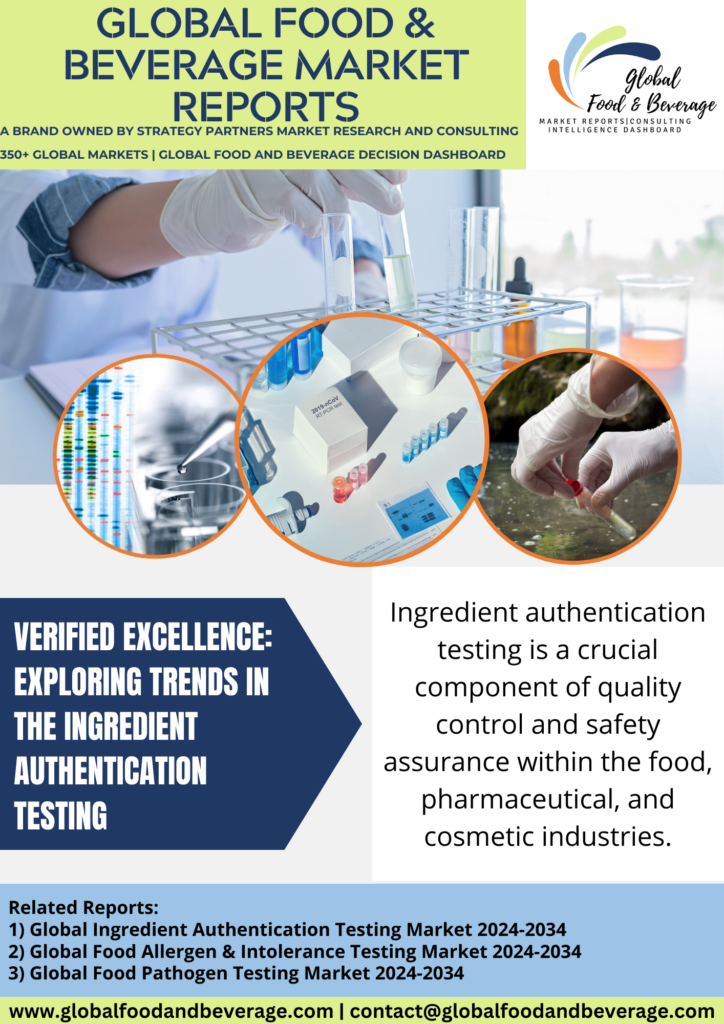Verified Excellence: Exploring Trends in the Ingredient Authentication Testing Market
Ingredient authentication testing is a vital quality control measure employed across various industries, particularly in food and pharmaceuticals, to verify the authenticity and quality of raw materials or ingredients. This rigorous testing process is essential to ensure that products meet specified standards, adhere to regulatory requirements, and safeguard consumer safety.

In the food industry, ingredient authentication testing is employed to detect the presence of adulterants, contaminants, or substitutions in food products. This is especially crucial for high-value commodities such as spices, oils, and premium ingredients, where fraud or mislabeling can occur. Analytical techniques, including DNA testing, chromatography, and spectroscopy, are utilized to verify the origin and authenticity of ingredients, ensuring that consumers receive what is accurately represented on product labels.
In pharmaceuticals, ingredient authentication testing is a critical step in the quality control of active pharmaceutical ingredients (APIs). Ensuring the identity and purity of these ingredients is paramount to guarantee the efficacy and safety of pharmaceutical products. Sophisticated analytical methods, such as mass spectrometry and nuclear magnetic resonance (NMR) spectroscopy, are employed to authenticate the chemical composition of pharmaceutical ingredients and identify any impurities or deviations from the expected quality.
The rise of global supply chains has increased the complexity of ingredient sourcing, making ingredient authentication testing even more critical. With ingredients often sourced from various regions, the potential for unintentional contamination or deliberate adulteration poses challenges to product integrity. Stringent testing protocols and traceability measures help mitigate these risks, enabling manufacturers to maintain the highest standards of quality and authenticity.
Apart from regulatory compliance and quality assurance, ingredient authentication testing plays a crucial role in protecting consumer trust and brand reputation. Consumers rely on accurate product labeling and expect the ingredients listed to be authentic and safe. Rigorous testing protocols contribute to transparency in the supply chain, fostering confidence among consumers and stakeholders.
ADVANCEMENTS
Ingredient authentication testing aim to address concerns related to food safety, fraud prevention, and quality control in the food industry. One significant breakthrough is the adoption of advanced analytical techniques for accurate and reliable authentication. Mass spectrometry, DNA sequencing, isotopic analysis, and chromatography methods are increasingly utilized to verify the identity and origin of food ingredients, ensuring compliance with labeling regulations and preventing adulteration.
The development of rapid and portable testing technologies represents a key advancement. Handheld devices and point-of-care testing kits equipped with spectroscopy or DNA analysis capabilities enable quick on-site authentication, reducing the time and resources required for laboratory testing. This is particularly valuable for identifying potential adulteration or contamination in the supply chain.
Blockchain technology is being integrated into ingredient authentication systems to enhance traceability and transparency. By recording every step of the supply chain on a secure and immutable ledger, blockchain ensures that the authenticity of ingredients can be verified at any point in the production process, promoting trust among consumers and stakeholders.
Advancements in artificial intelligence (AI) and machine learning contribute to more sophisticated data analysis in ingredient authentication. These technologies can analyze large datasets to identify patterns and anomalies, improving the accuracy of authentication results and aiding in the detection of subtle forms of adulteration.
The use of stable isotope analysis and trace element profiling is becoming more prevalent for geographical and botanical authentication. These techniques help verify the authenticity of ingredients by assessing their elemental composition, allowing for the identification of specific markers indicative of geographic origin or botanical characteristics.
CHALLENGES
Ingredient authentication testing faces challenges related to the identification and verification of raw materials used in various industries, including food, pharmaceuticals, and cosmetics. One significant challenge is the complexity of supply chains, especially in globalized markets. The intricate networks of suppliers and the potential for ingredient adulteration make it challenging to trace the origin and authenticity of raw materials.
Adulteration and fraud pose ongoing challenges in ingredient authentication. Unscrupulous practices, such as dilution, substitution, or mislabeling of ingredients, compromise the quality and safety of products. Developing robust testing methods to detect and prevent adulteration is essential for maintaining the integrity of supply chains.
The diversity of raw materials used in different industries adds complexity to authentication testing. Each ingredient may have unique characteristics and markers that require specialized testing methods. Developing comprehensive and accurate testing protocols for a wide range of ingredients is a constant challenge.
Regulatory compliance is a complex challenge, given the varying standards and regulations across industries and regions. Ensuring that ingredient authentication testing meets the requirements of different regulatory bodies demands continuous diligence to stay updated and adhere to evolving standards.
Rapid technological advancements in testing methodologies and equipment present challenges in terms of standardization and validation. Establishing consistent and reliable testing methods that can be universally applied across industries is an ongoing effort.
Market competition adds pressure to continuously improve and innovate ingredient authentication testing. Staying ahead of fraudulent practices and meeting the demands of discerning consumers require continuous investment in research and development.
CONCLUSION
Ingredient authentication testing emerges as a crucial guardian of quality and integrity in the global supply chain. As the food industry navigates increasing complexity and globalization, the role of stringent testing protocols becomes paramount. Ensuring the authenticity of ingredients through advanced analytical techniques and technology not only safeguards against fraud but also fosters consumer trust. The industry’s commitment to transparency and accurate labeling is essential in meeting the demands of an informed and discerning market. The future holds a promise of continued innovation in authentication methods, providing a resilient defense against adulteration and reinforcing a foundation of honesty and quality in the diverse world of food ingredients.
